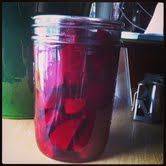 Pickling is an ancient technique used to preserve foods so people could travel at great lengths (often by ship) without running out of supplies. It was once believed that the pickling process was thought to give people additional vitamins, but in reality it was that pickling increased vegetable consumption, which are the true vitamin bearers.
Pickling is an ancient technique used to preserve foods so people could travel at great lengths (often by ship) without running out of supplies. It was once believed that the pickling process was thought to give people additional vitamins, but in reality it was that pickling increased vegetable consumption, which are the true vitamin bearers.
The pickling process isn’t as hard as many books and resources claim. It is also isn’t time consuming, messy, or expensive. If you’re curious to include pickling as a part of your seasonal process, you can easily create additional variety to your pantry by keeping a few items on hand, and in mind. First of all, starting out, save those reusable mason jars and rings you get with gifted homemade jam. Second, invest in having a box of new lids (size appropriate to the jars on hand). Whether you want to pickle or can, these are the only tools you really need. Don’t worry about investing in a pressure cooker; they are expensive and mostly unnecessary (unless you’re working in large batches). Third, pickling is all about using the acidity of the vinegar to preserve the food, so the primary focus is creating a simple brine and storing the food appropriately.
Pickling can come in very handy, especially this time of year, for preserving extra vegetables. I recently had about 20 jalapeños from a few plants in my garden, and I didn’t want to waste them. Pickled jalapeños are a favorite condiment I like to add to homemade queso dip or tacos. The pickled red onions also make tasty taco toppers.
 Pickled Jalapeños (adapted from Tasty Kitchen.com)
Pickled Jalapeños (adapted from Tasty Kitchen.com)
- 15-20 jalapeños
- 3 garlic cloves, smashed and peeled
- 1 cup water
- 1 cup distilled white vinegar
- 4 Tablespoons sugar
- 2 Tablespoons salt
Slice the jalapeños and discard the stems. In a saucepan combine all ingredients, except the jalapeños. Bring to a boil so the sugar and salt dissolve. Once at a boil, submerge the jalapeños and remove pan from heat. Let stand 10-15 minutes. Next, transfer the jalapeños to a clean jar and top off with juice from the pan. Cap and store in the refrigerator.
Pickled Red Onions (adapted from Inspired Taste.net)
- 1 medium red onion
- 1 cinnamon stick
- 3 whole cloves
- Pinch of crushed red pepper
- ½ cup apple cider vinegar
- ¼ cup lime juice
- ¼ to ½ cup sugar
- 1 Tablespoon salt
 Slice the onions and put them into a bowl. Cover onions with boiling water and drain after 10 seconds. Place onions in jar.
Slice the onions and put them into a bowl. Cover onions with boiling water and drain after 10 seconds. Place onions in jar.
Toast cloves, cinnamon, and red pepper in a small saucepan over medium heat until fragrant. Whisk in vinegar, lime juice, sugar, and salt. Bring to a simmer and cook until sugar and salt are disloved. Taste for sweetness and add sugar if needed. Once sweetended to taste, pour brine over onions. Cap and store in refrigerator.
Pickled Beets
This is the recipe my family has used for over 30 years. We typically only do large batches, but I have adapted it some for a smaller batch. The general rule is for however many cups of beets you have, make 75% as much brine. For example: 1 cup chopped beets equals 3/4 cups brine mix (approximately).
- Beets – peeled and chopped into ½ inch pieces. Most recipes will tell you to boil, peel off the skins, and to be careful of the bleeding (beets stain). My shortcut? Invest in a box of latex gloves, wear all black and peel the beets with a vegetable peeler. It’s a lot cleaner, easier, and saves you tons of time!
 For the Brine, equal parts:
For the Brine, equal parts:
- Apple Cider Vinegar
- Sugar
- Water
Pack beets into the jar(s). Mix brine into a medium saucepan (depending on how much you’re making). Bring to a boil, mixing until sugar dissolves. Pour the brine over the beets and cap. Store in the refrigerator.
*Please note that these recipes are designed for temporary storage and all veggies should be eaten promptly!








